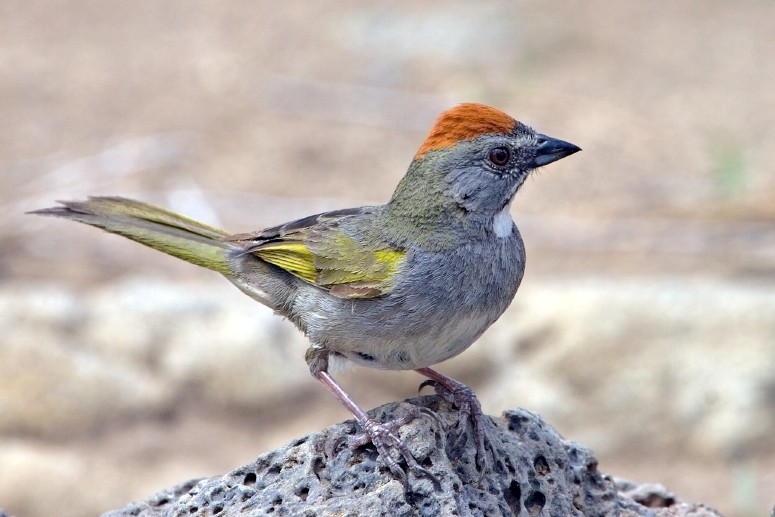Green-tailed Towhee
A species of Towhee Scientific name : Pipilo chlorurus Genus : Towhee
Green-tailed Towhee, A species of Towhee
Botanical name: Pipilo chlorurus
Genus: Towhee
Content
Description General Info
 Photo By http://www.naturespicsonline.com/ , used under CC-BY-SA-3.0 /Cropped and compressed from original
Photo By http://www.naturespicsonline.com/ , used under CC-BY-SA-3.0 /Cropped and compressed from original Description
The green-tailed towhee (Pipilo chlorurus) is the smallest towhee, but is still one of the larger members of the American sparrow family Passerellidae. Its breeding range covers most of the interior Western United States, with a winter range in Mexico and the southern edge of the Southwestern United States. This bird can be recognized by the bright green stripes on the edge of its wings. It has a distinct white throat and a rufous cap. It measures 7.25 in (18.4 cm) long and weighs 29 g (1.0 oz). It is fairly tame, but often stays hidden under a bush. It is fairly common in habitats with sagebrush and other such bushes. It is uncommonly seen because of its tendency to stay under cover. 
Size
18 cm (7.25 in)
Life Expectancy
7-8 years
Nest Placement
Shrub
Clutch Size
2 - 5 eggs
Incubation Period
1 - 2 broods
Number of Broods
11 - 13 days
Nestling Period
11 - 14 days
Feeding Habits
Green-tailed Towhee primarily consume seeds and insects, searching for food on the ground with a characteristic double-scratch foraging method. They eat pigweed, filaree, dandelion, ricegrass seeds, serviceberry, elderberry, raspberry, and various insects like beetles, bees, wasps, caterpillars, moths, grasshoppers, bugs, and flies.
Habitat
Green-tailed Towhee thrive in diverse habitats from mountain slopes and chaparral to open woodlands. They prefer environments with dense shrubbery, such as pinyon-juniper forests and sagebrush, often at elevations up to 10,000 feet. Post-disturbance areas with regrowth also provide suitable conditions. In winter, green-tailed Towhee move to lower arid regions, utilizing washes, thickets, and grasslands.
Nest Behavior
The female green-tailed Towhee solely constructs the nest over 2–5 days. Nesting behavior includes egg-laying and meticulous parental care.
Nest Characteristics
Green-tailed Towhee's nests are hidden at knee height in dense vegetation or low branches of various shrubs and small trees. These nests are deep cups of twigs, plant stems, and bark, lined with grasses, fine stems, rootlets, and hair. They measure approximately 6 inches in width and 3 inches in height, with a 2.5-inch wide and 1.5-inch deep cup.
Dite type
Granivorous
General Info
Feeding Habits
Bird food type
Bird Feeder Type

Ground

Platform
Behavior
The green-tailed Towhee exhibits a distinct foraging pattern, seeking food on the ground or within low shrubbery. As part of their reproductive routine, males aggressively defend territories upon return to their breeding areas, notably against similar species. This defiance is characterized by territorial songs, feather puffing, crest raising, and wing shaking. Their social structure is primarily monogamous, with occasional extra-pair coupling. Remarkably, males courtship involves gifting nesting materials and displaying a prominent tail posture. In colder seasons, they engage in small flocks, often alongside other sparrow species. They face predation from a variety of raptors and owls, with nest threats posed by assorted mammals and reptiles.
Species Status
Not globally threatened.

 Photo By http://www.naturespicsonline.com/ , used under CC-BY-SA-3.0 /Cropped and compressed from original
Photo By http://www.naturespicsonline.com/ , used under CC-BY-SA-3.0 /Cropped and compressed from original Scientific Classification
Phylum
Chordates Class
Birds Order
Perching birds Family
New world sparrows Genus
Towhee Species
Green-tailed Towhee